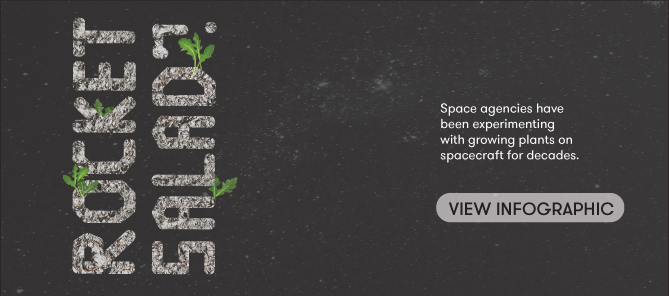Rocket salad: growing plants in space
Expert reviewers
Essentials
- Plant research in space has been going on for over 40 years.
- Studying plants in space can lead to new insights into plant physiology.
- Astronauts may need to be able to grow their own food on future long-distance space expeditions.
- Research into how plants grow in novel and challenging environments has benefits for us here on Earth.
- Scientists don’t yet know whether it will be possible to grow food on Mars.
Ever since Matt Damon got busy growing potatoes on Mars in the movie ‘The Martian’, many of us have been wondering (and some of us fiercely debating) how much of this is fact, and how much fiction. Could it really be possible to grow plants in space—on Mars, or perhaps the moon?
Why grow plants in space?
We’ve actually been growing plants in space for some time; not on Mars (we'll take a look at how possible this might be in the future a little later), but in the confined, microgravity environments of various spacecraft in low-Earth orbit. In August 2015, astronauts on the International Space Station (ISS) ate space-grown salad, snacking on lettuce grown and harvested there. It was just the latest episode in several decades of experiments to cultivate plants in space. The first plants to be grown on manned spacecraft were flax, leek, onion and Chinese cabbage, cultivated on the Soviet space station Salyut 1. Since then, over 40 plant species, both edible and non-edible, have been grown in various spacecraft.
Until recently, plants have been grown on spacecraft primarily for research purposes—to better understand their physiology and how they grow in different conditions, such as in microgravity and closed or confined environments.
In the last few years, however, NASA has started seriously investigating the potential of space-grown plants as a food source for astronauts. NASA has plans to send a crewed vehicle to Mars in the 2030s, making the ability to grow food in transit more important. That’s because it may be impossible to carry all the packaged food needed for such a long-distance expedition. Seeds, on the other hand, take up only a small amount of room—and, once the plant has grown and is producing seeds, it may be possible to grow several batches of food from a single plant. Space-grown plants could also supplement astronauts’ packaged diet with fresh nutritious produce. While it’s not yet happening yet in a large volume, plants grown on spacecraft could also potentially reduce carbon dioxide and produce oxygen, as well as provide potable water through transpiration GLOSSARY transpirationevaporation of water from plant leaves .
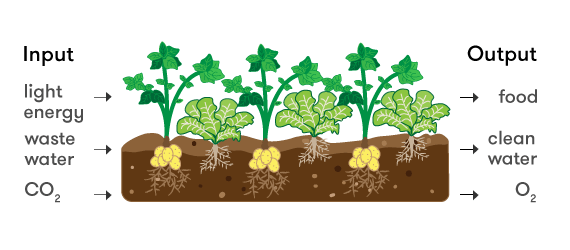
There are other reasons for growing plants on spacecraft, too—not just for future missions to Mars, but for astronauts currently living on the ISS. Fresh food provides valuable nutrients and antioxidants, as well as variety from the dried and packaged fare that makes up most of an astronaut’s diet. While supply ships do deliver a limited amount of fresh food to the ISS, this happens only occasionally and, with refrigeration reserved for samples from research experiments, the food has to be consumed pretty quickly.
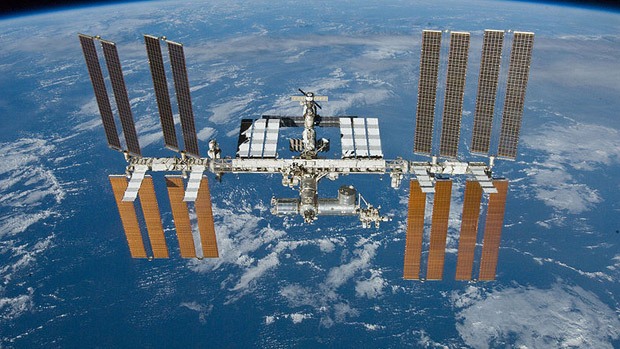
It seems there could be psychological benefits to a bit of space gardening, too—with some astronauts observing that having plants to tend to has positive effects on their mood. Plants are a living, growing piece of Earth—their smell and colour can inject a bit of sensory variety into a primarily man-made and sterile environment. With the sun rising and setting many times a day on the ISS, the growth of plants can also be a way for astronauts to mark the passing of time.
One of the things I really miss up here … is the ability to be outside and experience nature.Scott Kelly, astronaut
How does your garden grow (with little soil, water or gravity)?
But hang on—aren’t there are a few essentials that plants need to be able to grow? Things there aren’t too much of on a spacecraft … like soil, water and room—and, for that matter, gravity. Experiments over the years have been slowly but surely developing ways of growing plants in space with very little of these seemingly essential requirements.
All plants need water—but, clearly, carting around huge amounts of the good stuff isn’t practical on the ISS, or for future missions to Mars. Water is scarce on the ISS, and is rationed and recycled as much as possible—about 93 per cent of all water on the ISS is reclaimed from filtered condensate (from the collected breath, sweat, and even urine of its inhabitants). It’s a similar story with soil: a spacecraft isn’t going to be able to haul around masses of heavy, gritty stuff in which to grow plants.
For these reasons, plant-growth systems in space are designed to use recycled water and small amounts of growth media. The ‘Veggie’ system (which we’ll take a closer look at in a moment), for example, consists of single-use plant ‘pillows’ containing seeds in a small amount of calcined clay GLOSSARY calcined clayclay baked at a very high temperature. It becomes stable and porous, helping to trap both water and air in the root zone. media with controlled release fertiliser. The plant pillows are given a first wetting via a syringe, then water is added to fill a root-mat reservoir. As the seedlings grow, additional water is added from the water bag into the plant pillow or reservoir according to a schedule, using the syringe mechanism to avoid leaks (though not entirely successfully, with scientists now looking at how they can improve the watering system).
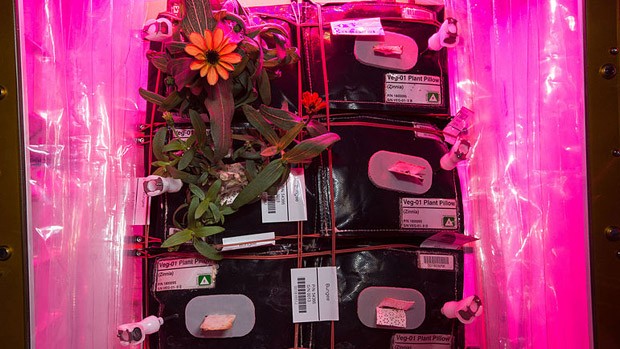
What about gravity? For almost a century and a half it was thought that gravity was necessary for roots to grow in the right direction—down, and away from the leaves. It was Charles Darwin who showed that, when plants were grown on a slanted surface, the roots grew skewed to one side. It was thought that this skewing was the result of gravity, combined with roots’ tendency to ‘feel’ their way across the surface they’re growing on. But, in 2010, it was found that the roots of plants grown on the ISS also grew skewed. Scientists were astounded—the skewing couldn’t be the result of gravity, so what was telling the roots which way to grow? Researchers hypothesised that, in the absence of gravity, roots instead use light as their cue to tell them which way to grow (away from the leaves, and the light). The light source, though, needs to be sufficiently strong and directed. What’s more, they found that, in space, plants regulate the way they express their genes in order to deal with their new, microgravity environment. Among other changes in gene expression, the genes involved in light-sensing, which on Earth are normally expressed in leaves, are in space expressed in roots. So roots and shoots will, in the absence of gravity as a primary stimulus, make use of other stimuli. They are very adaptive!
Growing plants with electric light
An important technological advance enabling plants to be grown in space has been the development of light-emitting diodes, or LEDs. In early experiments, fluorescent or high-pressure sodium lamps GLOSSARY sodium lampsgas-discharge lamps that use sodium in an excited state to produce light were used as the light source. They were far from ideal, using up a huge amount of energy. Because sodium and fluorescent lights emit heat, they also couldn’t be placed too close to the plants, as they tended to scorch them. But from the 1990s, experiments with new materials resulted in the development of LEDs and, by the early 2000s, more LED types, and more efficient LEDs, were commercially available.
When it comes to space gardens, LEDs have lots of advantages. Perhaps most important is the fact that they use much less energy than the old-school fluorescent or sodium lights. They can also be used in a targeted way, being moved closer to, or further from, the plant canopy as needed; because LEDs emit little heat, moving them closer to the plants won’t fry them. Specific wavelengths can also be selected for specific plant responses, meaning less wasted light.
Benefits back home
Knowing how to grow plants in confined spaces isn’t just of benefit to salad-craving astronauts. Experiments with, and technologies developed for, plant production on the ISS have also proved valuable for agriculture back here on Earth, especially for areas in which water is scarce, soil is poor or space is limited. Plant scientists at Kennedy Space Center in Florida, for example, were one of the first groups to demonstrate vertical farming—in which plants are grown in hydroponic trays stacked in layers, with an electric light source. It’s a method now used in many countries across the globe.
Plant experiments on the ISS have also led to the development of an air purification device which is useful in preventing mould. Scientists on the space station observed that their plants, grown in contained spaces, were being destroyed by the build-up of a naturally occurring plant hormone called ethylene. In collaboration with the University of Wisconsin, researchers developed an ethylene removal system that banishes viruses, bacteria and mould from the plant-growth system.

Veggie: salad on the space station
Recent space-gardening experiments on the ISS have taken place using a plant-growing system dubbed ‘Veggie’. As we’ve seen, while other experiments have been mainly concerned with examining plant physiology under different conditions, such as microgravity, Veggie is intended to produce food for astronauts.
Veggie consists of plant ‘pillows’ impregnated with seeds (which are sent to the ISS dry, and installed and hydrated in orbit), a root mat, and growth media consisting of calcined clay and controlled release fertiliser. Expandable plastic bellows form walls around the unit, and there’s a flat panel bank of LEDs at the top, which can be moved closer to or farther away from the plants. The Veggie units are collapsible, so they can be stored in a locker (taking up little space) until needed.
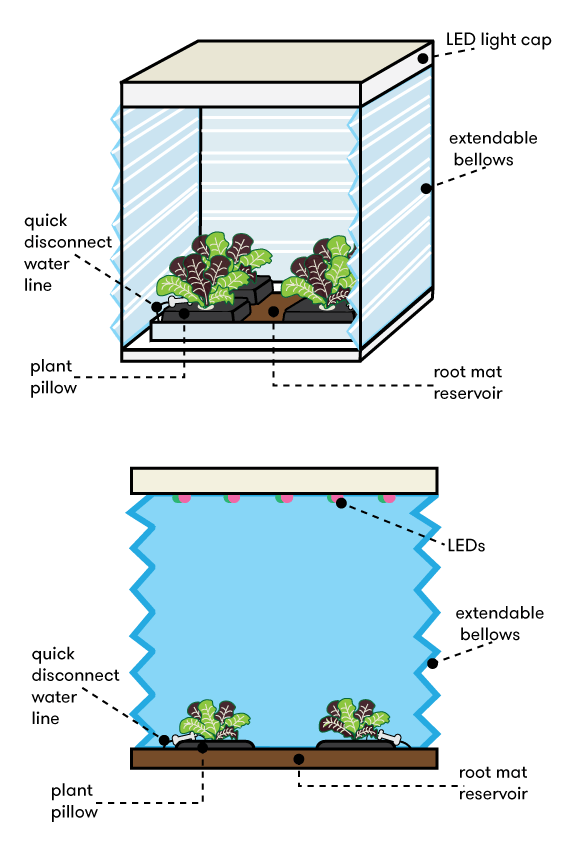
If you find it a stretch to wait for the final beep of the microwave before digging into some lunch, spare a thought for the ISS astronauts anticipating their first space-grown salad. The first Veggie unit was installed on the ISS in May 2014. A batch of lettuce was grown for 33 days, harvested, then returned to Earth to be tested for safety at NASA’s Kennedy Space Center. Having been determined to be safe to eat, a second batch was grown for 33 days and harvested. To be on the safe side, astronauts wiped their lettuce leaves with sanitising wipes before, finally, chowing down on ‘Outredgeous’ red romaine lettuce in August 2015. They ate half the produce, with the other half being packaged up, frozen and sent back to Earth for tests.
Next on the agenda for cultivation in Veggie was a flowering plant: zinnia. The choice of flowers wasn’t just to pretty up the place. Flowering plants take longer and are harder to grow than leaf crops (they’re more sensitive to variations in light, for example), and it was hoped that successfully growing zinnias would pave the way for growing other flowering plants on the ISS, such as tomatoes. The zinnias bloomed in January 2016 and were harvested on the ISS on Valentine’s Day 2016. A delivery of tomato seeds to the ISS is planned for 2017 or 2018.
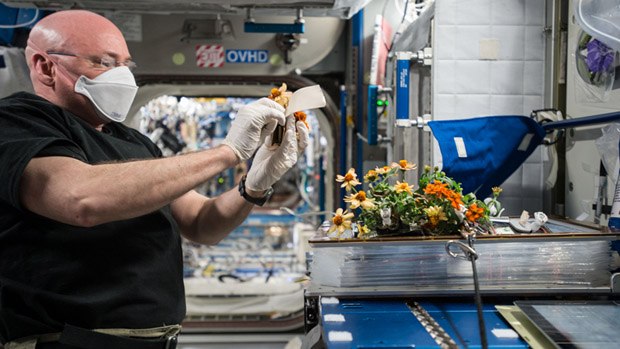
Farming on Mars?
What about Mars? Might growing plants on the Red Planet might actually be possible at some time in the future?
Short answer: it won’t be easy. First of all, sunlight is at a premium on Mars. Thanks to its position further from the sun, and its dust storms, Mars gets less than half the amount of light enjoyed by us on Earth. It’s possible, though, that some low-latitude areas of the planet may get enough sun in which to grow plants. Then there’s Mars’ extreme cold, thin atmosphere and UV radiation—not exactly plant friendly. Finally, there’s the planet’s rocky surface. On first glance, it’s not that great for planting out a row of spuds. Interestingly, however, studies of Mars soil and meteorites have detected a number of nutrients which are essential for plants, including nitrogen. Plants have also been grown in simulated Martian soil. Nevertheless, because of the harsh conditions on Mars, any future plant-growing will likely be done in a protective structure (perhaps even underground) under LED lights, than in a nice garden bed in Martian soil.
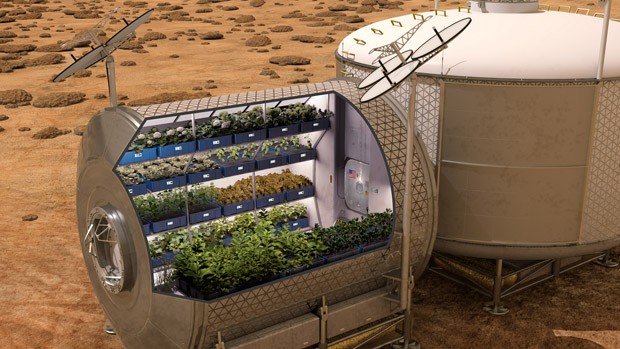
Until then, continued experiments on the ISS will hopefully throw up some insights into how plants can be grown successfully in novel and challenging environments. That’s good news not only for astronauts, but—especially with the prospect of a changing climate and growing population—for us back here on Earth.






